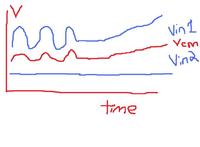giri_lp
Member level 3

vin cm
The concept of input CM in differential amplifier is unclear. Is this CM is DC CM or AC CM? When we apply an ac signal to the diffrential amplifier What is the CM voltage? Is this the offset from 0 or do we have to look this with refrerence to differential signal ? Please explain the Vin CM concept in differential amplifier
The concept of input CM in differential amplifier is unclear. Is this CM is DC CM or AC CM? When we apply an ac signal to the diffrential amplifier What is the CM voltage? Is this the offset from 0 or do we have to look this with refrerence to differential signal ? Please explain the Vin CM concept in differential amplifier





